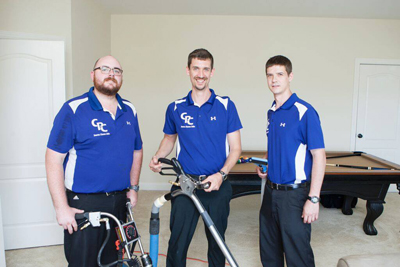Even with the rekindled interest in hardwood, tile, and stone flooring in the recent years, carpeting is still the most popular form of flooring on the market. It provides natural warmth and noise insulation to any room. Plus, you can’t beat the comfort it supplies your feet. However, over time, it may require some special attention, since the surface needs constant vacuuming and the rug itself may need occasional repair, most often in the form of carpet stretching.
Why do I need it?
Like all flooring, carpeting is going to sustain some serious wear and tear. Especially in high traffic areas (family room, hallways, stairs) the surface will get a bit worn down or stains may occur. The real problem is when the carpeting becomes unfastened. Unlike hardwood or stone floors that come in solid pieces, carpeting is sewn together in layers of materials and fabrics, which means that the surface or the entire installation itself can slowly come undone over time. Often this is seen in the form of wrinkles that usually occur at the edges of a room. But if not addressed immediately, these wrinkles can spread in number and size, soon taking over an entire area of the house. Not only are these folds unsightly, they’re also dangerous since they’re a camouflaged tripping hazard to children, the elderly, and other guests. So to prevent the problem from getting worse and save yourself from a fall or a potential lawsuit, you’ll want to get this repaired as soon as possible.
Once your carpet starts to ripple, it’ll only keep getting worse. That’s because carpet is intended to lay flat at all times; a small ripple not only puts more wear and tear on the carpet, but causes it to move when you walk across it. That movement causes—you guessed it—more ripples. Soon your carpet will begin to look more like an ocean than a floor, and that’s a problem. If you find yourself in that situation, don’t worry. You probably won’t need to replace the carpet.
How CPC can help?

Whether it’s coming up by itself or you pull it up to get it out of the way while remodeling, you’ll want to reinstall carpeting quickly. Carpet Pro Cleaners has trained technicians ready to serve you. We have the time, tools and the knowledge to remove wrinkles that may have developed from poor installation, moving heavy furniture, or years of wear and tear.
Carpet stretching is a very common carpet repair task. For the most part, stretching it will remove the buckles and return it to its natural state as a flat, attractive floor covering. Carpet stretching is simple in theory: it involves pulling up the edges of the carpet, re-stretching the carpet so it’s properly taught, trimming any excess that’s been created, and re-securing the carpet in its new place. But in practice, it’s a considerably involved process, involving unique tools and proper technique to actually accomplish a successful carpet stretch.
The genesis of most wrinkles and ripples that develop in your wall to wall carpet over time, can usually be traced back to poor installation. Proper installation requires a tool called a carpet stretcher or a power stretcher. (Not a kicker, kickers alone, aren’t nearly enough.) Unfortunately, just like carpet cleaners, carpet installers do business with all levels of experience with varying skills sets. The results may not always be desirable. Carpet Pro Cleaners employs only trained experts with many years of experience to meet your needs and get your carpet back to its original condition. Here we will describe how to identify problems and describe in detail the execution of a carpet stretching. When you see carpet ripples, carpet wrinkles, or bunched-up carpet, that’s when you know you need to have your carpet stretched. A loose carpet can usually be re-stretched without needing to take apart seams. If seams do need to be taken apart, it opens up a whole other can of worms and may or may not be desired depending on varying circumstances.
Furniture moving when stretching carpet:
Carpet stretching is best completed in an empty room free of any obstacles that can hinder the work or the results. However, if there is some furniture in the room, it is sometimes possible to use our carpet stretcher without having to clear the room entirely. Often we can move the furniture from one side of the room to the other and stretch one side of the room at a time. However, there are instances when rooms or areas need to be entirely cleared to allow an unobstructed working area. After an on site inspection, a CPC technician can provide an estimate including all necessary furniture moving and (if applicable) a separate estimate for customers able to remove the furniture prior to stretching.
What You Really Need To Know About Carpet Stretching (Explained by a Pro)
Carpet Stretching Basics: The “why” of carpet stretching is that it keeps the carpet in place, flat, and smooth against the floor, as it is intended to be. Carpet is always stretched taught during the first installation, to ensure that it covers the floor evenly and smoothly. However, carpets may need to be stretched during carpet repair if they later develop buckles and ripples, which can be caused by any of the following:
- Poor installation – If your carpet is improperly installed (due to insufficient or nonexistent stretching, or improperly securing the carpet), it may need to be re-stretched as a carpet repair.
- Heavy traffic – If your carpet gets heavy traffic beyond normal foot travel (such as walkers or wheelchairs, tricycles, etc.), it may eventually come loose, even if it was installed perfectly.
- Moving heavy furniture – Sliding heavy furniture across your carpet can cause its layers to ripple and leave the carpet loose and buckled.
- Wrong pairing of carpet with padding – Different types of carpet pile are meant to be used with specific types of carpet padding, so the carpet is properly secured and supported. The manufacturer’s guide or an experienced professional can help you ensure you have a proper match before your install your carpet; otherwise, you may deal with ripples later.
- Delamination – This means the latex that keeps the carpet backing intact has deteriorating; the carpet may start to fall apart by losing fiber or rippling.
Tools of the Trade:
If you decide to attempt carpet stretching on your own, these tools will be essential; if you don’t own them, most should be available to buy or rent, and aren’t too expensive. A professional carpet repair person will have all of these tools (and probably more) on hand; hiring out your carpet repair to a seasoned veteran is still more affordable than replacing it with new carpet, so whether you try it yourself or pay someone to do it for you, these tools are cost-savers. (Carpet Pro Cleaners shall claim no responsibility, nor be held liable in any way for those who take any information from this site and attempt stretching or repairing their own carpet.)
- Slotted blade knife / carpet knife – This knife will play a role in almost every carpet repair job imaginable. When you stretch a carpet, the carpet knife allows you to remove spare carpet created around the edge after the carpet is stretched tight.
- Power carpet stretcher – A carpet can’t be properly stretched without a power stretcher; there’s no way around this. If your carpet wasn’t installed using one, it’ll need to be repaired with one because it’s surely buckling! The power stretcher is a very long pole that braces against one wall and uses the force of a lever to stretch the carpet toward the opposite side of the room. That force is much, much stronger than any force a person can exert alone (or with the kicker, #3 on the list), so using it is non-negotiable. (It’s also one of the most expensive tools of the trade.)
- Kicker / knee stretcher – A sort of mini version of the power carpet stretcher, the knee stretcher uses leg-power to help finish off, around the edges, the work that the power stretcher does.
- Industrial carpet staple gun – This isn’t your grandparents’ staple gun (unless your grandparents repair carpet). Designed with a much narrower staple that fits between the carpet nap, a carpet staple gun is always a good tool to have at the ready. It’s not required in carpet stretching, but because the carpet gets so tight, the tack strip may need some assistance in assuring the carpet is without-a-doubt secure. The staple gun is that assistance.
- Awl – An awl helps you detach carpet from the tack strip; it looks something like an ice pick. It’s simple and very helpful for what it does.
- Hammer – Probably a good rule of thumb: If you don’t have a hammer around, carpet stretching is probably not something you’re prepared to do.
Step by Step guide:
If you set out to pursue carpet repair, specifically carpet stretching, on your own, make sure you’re up to the task. Do your homework before you touch anything. If you’re still not sure what you’re doing, it’s best to hire a pro.
Below you’ll find a very simplified version of the basic steps of carpet stretching; it’s by no means the step-by-step guide. If you don’t know how to do this properly, I strongly advise that you hire a pro. If you do decide to go ahead, work slowly, use your head, and above all—be careful.
Before carpet stretching can even begin, you need to know how tight it’s supposed to be. When a manufacturer makes carpet, they specify not only the type of padding that should be used with it, but how tight it should be stretched. For example, tufted carpet with a backing made of synthetic fiber shouldn’t be pulled as tight as a similar carpet with jute backing. Stretching carpet to the wrong tightness can damage the carpet.
If you have the tools and know how tight you need to stretch the carpet, then you’re ready to embark on the carpet stretching journey, as outlined below.
First clear the room. If you’re experienced you can probably leave some furniture inside, but if you’re new to carpet repair, I’m sure you’ll have a much easier time if you empty the room before you start.
The carpet will probably only need to be stretched in one direction. Figure out what that direction is.
If there are any metal strips in the way, remove them. Metal strips come in more styles than I have room for here: some are flat and require the removal of nails first, others are of the clamp down metal variety and need to be pried carefully with a chisel or stair tool. If it’s another kind, you’ll need to figure out how to get it up without damaging the carpet.
Starting in one corner, insert the awl through the carpet a half-foot or so from the wall. Lift the carpet edge and pull up the carpet. If there’s no awl available, pliers will do in a pinch.
Get out the carpet stretcher and arrange it so the head is a few inches out from the wall toward which you’re stretching, and the foot is solid against the baseboard of the opposite wall. Don’t stretch the carpet any farther than you need to or it can tear. The stretcher is certainly strong enough to rip even thick carpet. Adjust the stretching as needed using the knee stretcher.
By gently pushing the power stretcher’s handle, pull the carpet toward the corner, making sure to do so at a slight angle.
Making sure to leave enough of an edge to tuck in between the wall and tack strip, carefully use a sharp carpet knife to remove the extra carpet that the stretching has left along the edge. If there’s still too much, trim a bit more. If you cut it too short, you can probably generate enough by stretching the carpet just a little bit more. Be careful not to rip it.
For the portion you’ve already stretched, push the carpet onto the tack strip’s nails. If it’s not staying, secure it in place with the staple gun. Make sure, though, that you don’t staple down the nap, but just the backing.
Make your way carefully around the room in the same manner, stretching carpet, trimming the excess, tacking down the edge, and tucking the edge in.
When this is all done, we’ll discuss the results, replace your furniture, and ask you to enjoy your wonderfully stretched carpet! Call us anytime for a free estimate or to discuss possible options.
How will I know if my carpets need stretching?
Wrinkles, ripples or waves may develop slowly over time or during the moving of heavy furniture. These waves can develop anywhere in any room and along base boards of walls.
What is the value in carpet stretching?
Wrinkles, ripples or lumps that develop in carpeting and are left unattended, may develop permanent crease in the backing of the carpet leading to irreversible damage to the carpet. Stretching loose carpet will extend the life of the carpet and eliminate unsightly wrinkles.
How much does carpet stretching cost?
The pricing for stretching is roughly equated to the amount of time it will take the technician to complete the job. For this reason, it is difficult to relay accurate pricing via phone and is why we have delegated an approximate pricing based on the number of areas that may require stretching.
How long will it take to have my carpet stretched?
The duration of a stretching job is typically dependent upon the severity and frequency of the wrinkles in the carpet, as well as the amount of furniture required to be moved in each room. An average stretching job for wrinkles in three areas will take 1 to 1.5 hours.

